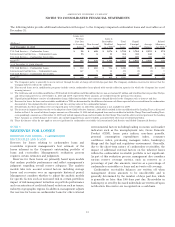American Express 2010 Annual Report Download - page 74
Download and view the complete annual report
Please find page 74 of the 2010 American Express annual report below. You can navigate through the pages in the report by either clicking on the pages listed below, or by using the keyword search tool below to find specific information within the annual report.AMERICAN EXPRESS COMPANY
NOTES TO CONSOLIDATED FINANCIAL STATEMENTS
NOTES TO CONSOLIDATED
FINANCIAL STATEMENTS
NOTE 1
SUMMARY OF SIGNIFICANT
ACCOUNTING POLICIES
THE COMPANY
American Express is a global service company that provides
customers with access to products, insights and experiences that
enrich lives and build business success.The Company’s principal
products and services are charge and credit payment card
products and travel-related services offered to consumers and
businesses around the world. The Company’s various products
and services are sold globally to diverse customer groups,
including consumers, small businesses, mid-sized companies
and large corporations. These products and services are sold
through various channels, including direct mail, on-line
applications, targeted direct and third-party sales forces and
direct response advertising.
PRINCIPLES OF CONSOLIDATION
The Consolidated Financial Statements of the Company are
prepared in conformity with U.S. generally accepted accounting
principles (GAAP). All significant intercompany transactions
are eliminated.
The Company consolidates all entities in which the Company
holds a “controlling financial interest.” For voting interest
entities, the Company is considered to hold a controlling
financial interest when the Company is able to exercise
control over the investees’ operating and financial decisions.
For variable interest entities (VIEs), the Company is considered
to hold a controlling financial interest when it is determined to
be the primary beneficiary. Prior to the adoption of ASU
No. 2009-17, Consolidation (Topic 810): Improvements to
Financial Reporting by Enterprises Involved with Variable
Interest Entities (effective January 1, 2010), a primary
beneficiary was the party that absorbs a majority of the VIE’s
expected losses or receive a majority of the VIE’s expected
residual returns. For VIEs, subsequent to the adoption of
ASU No. 2009-17, a primary beneficiary is a party that has
both: (1) the power to direct the activities of a VIE that most
significantly impact that entity’s economic performance, and
(2) the obligation to absorb losses, or the right to receive
benefits, from the VIE that could potentially be significant to
the VIE. The determination of whether an entity is a VIE is
based on the amount and characteristics of the entity’s equity.
Entities in which the Company’s voting interest in common
equity does not provide the Company with control, but allows
the Company to exert significant influence over their financial
and operating decisions are accounted for under the equity
method. All other investments in equity securities, to the
extent that they are not considered marketable securities, are
accounted for under the cost method.
FOREIGN CURRENCY
Assets and liabilities denominated in foreign currencies are
translated into U.S. dollars based upon exchange rates
prevailing at the end of each year. The resulting translation
adjustments, along with any related qualifying hedge and tax
effects, are included in accumulated other comprehensive (loss)
income (AOCI), a component of shareholders’ equity.
Translation adjustments, including qualifying hedge and tax
effects, are reclassified to earnings upon the sale or
substantial liquidation of investments in foreign operations.
Revenues and expenses are translated at the average month-
end exchange rates during the year. Gains and losses related to
transactions in a currency other than the functional currency,
including operations outside the U.S. where the functional
currency is the U.S. dollar, are reported net in the Company’s
Consolidated Statements of Income, in other non-interest
revenue, interest income, interest expense, or other, net
expense, depending on the nature of the activity. Net foreign
currency transaction gains amounted to approximately
$138 million, $205 million and $15 million in 2010, 2009 and
2008, respectively.
AMOUNTS BASED ON ESTIMATES AND
ASSUMPTIONS
Accounting estimates are an integral part of the Consolidated
Financial Statements. These estimates are based, in part, on
management’s assumptions concerning future events. Among
the more significant assumptions are those that relate to
reserves for cardmember losses relating to loans and charge
card receivables, reserves for Membership Rewards costs, fair
value measurement, goodwill and income taxes. These
accounting estimates reflect the best judgment of
management, but actual results could differ.
TOTAL REVENUES NET OF INTEREST EXPENSE
Discount Revenue
Discount revenue represents fees charged to merchants with
which the Company, or its GNS partners, has entered into card
acceptance agreements for facilitating transactions between the
merchants and the Company’s cardmembers. The discount
generally is deducted from the payment to the merchant and
recorded as discount revenue at the time the charge is captured.
Net Card Fees
Card fees are deferred and recognized on a straight-line basis
over the 12-month card membership period, net of deferred
direct card acquisition costs and a reserve for projected
membership cancellations. Charge card fees are recognized in
net card fees in the Consolidated Statements of Income and the
unamortized net card fee balance is reported in other liabilities
on the Consolidated Balance Sheets (refer to Note 11). Loan
product fees are considered an enhancement to the yield on the
product, and are recognized in interest and fees on loans in the
Consolidated Statements of Income. The unamortized net card
72
























